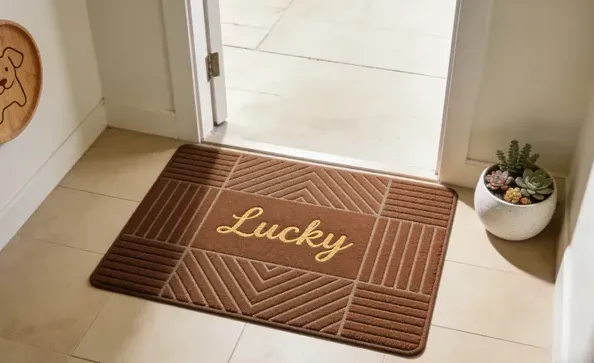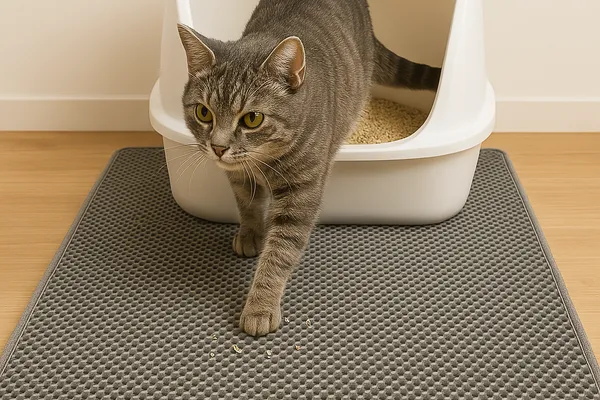I once spilled water on my cat litter mat. I wondered if it could handle a good wash.
Yes, most cat litter mats are washable. They are made from sturdy materials like PVC or rubber, so they can withstand a quick rinse or soak. This helps keep your home fresher. A clean mat also protects floors. It is a simple task that delivers big benefits.
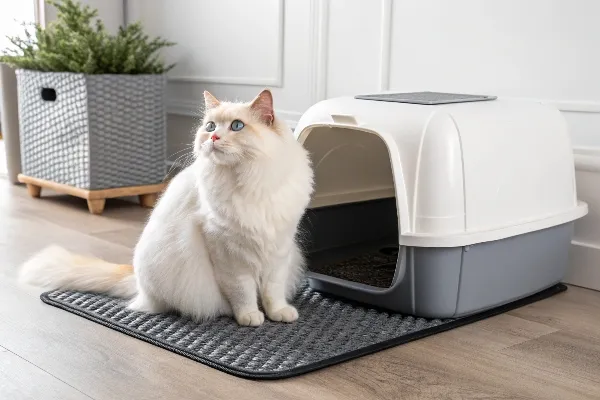
I remember struggling with the smells that stuck to the mat. After I washed it, I noticed the difference. My home smelled better, and my cat seemed more at ease.
How do you clean a cat litter mat?
I used to brush away litter by hand and hope for the best. It took too long. I needed a faster, deeper clean.
You can clean a cat litter mat by shaking off debris, rinsing it with warm water, and using mild soap1 if needed. This removes trapped litter and odor. It keeps your space fresh.
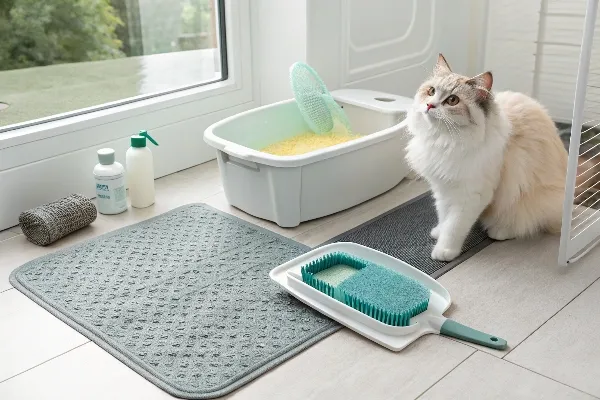
Steps for Effective Cleaning
I struggled at first. My cat tracked litter everywhere. The mat helped trap pieces, but it also trapped unpleasant smells. I tried to fix this by wiping the mat with paper towels. That just smeared things around. Finally, I adopted a clear routine that tackled both litter particles and odors:
-
Shake Off Loose Debris
I take the mat outside or over a trash bin. I shake it gently to remove loose litter. If the mat has deep grooves or pockets, I tap it on the edge of the bin. This step prevents litter from going down the drain later. I also use a small brush to loosen stubborn particles. -
Rinse with Warm Water
Warm water rinses away dirt and leftover litter. I use a garden hose or my bathtub faucet. I angle the mat so the runoff goes straight down the drain or onto the ground. It is surprising how much debris clings to the grooves of the mat. -
Mild Soap or Detergent
If the mat smells, I add a mild dish soap or pet-safe cleaner. I lightly scrub the surface with a soft brush or a cloth. I focus on the ridges or honeycomb pockets. That is where most of the dirt hides. A gentle cleanser dissolves any residue that causes odors. I avoid harsh chemicals because they can irritate my cat’s paws. -
Rinse Thoroughly
I rinse the mat once again with clean water. I make sure all soap is gone, since leftover residue can bother my cat. Some mats, especially those made of rubber or PVC, handle repeated rinses without issue. Others, like foam-based mats, might require a more delicate approach. -
Air Dry Completely
Before I return it to its spot, I let the mat air dry. If I place a damp mat on the floor, it can cause mildew underneath or a musty smell. I lean it against a wall or put it in direct sunlight. Once it is fully dry, I lay it back where it belongs. -
Maintain a Schedule
I clean my litter mat weekly. If my cat kicks more litter around or if I notice odors, I do it more often. This simple schedule prevents buildup. It keeps the area smelling clean.
| Cleaning Step | Por qué ayuda |
|---|---|
| Shake Off Debris | Removes most loose litter to reduce clogging |
| Rinse with Warm Water | Washes away surface dirt and small particles |
| Use Mild Soap | Dissolves stuck-on dirt, addresses odors |
| Rinse Again | Clears soap residue, avoids irritation |
| Air Dry Completely | Prevents mold and musty smells |
Following these steps changed my routine. My litter area became tidier. My cat also seemed happier. A clean mat means fewer tracked litter bits around the house. It also means less vacuuming. Now I no longer feel annoyed when I step on stray granules. A clean litter mat is worth the small effort.
Can I put a cat litter mat in the washing machine?
I once felt lazy. I thought, “Why not toss the mat in the machine?” But I was not sure if it would ruin it.
Sí, many cat litter mats can be machine-washed. Check the manufacturer’s label first. If it says machine-safe, use a gentle cycle with mild detergent. Then air dry. Avoid high heat.
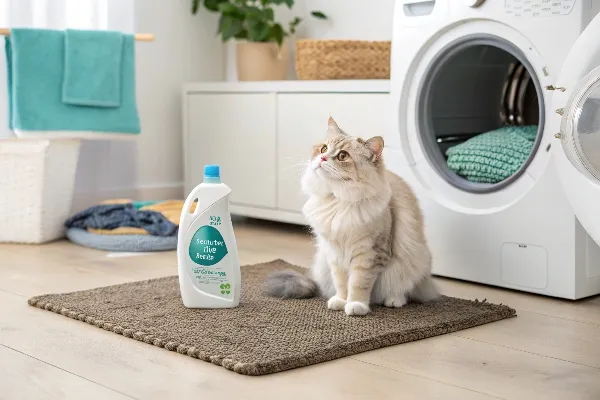
Machine Washing Tips and Precautions
I remember the day I pushed my cat litter mat into the washing machine. I had not read the care label. I used hot water and a strong detergent. The mat came out bent and slightly melted on one corner. It taught me a lesson about checking instructions. After that, I did more research:
-
Read the Label
Always look at the packaging or check the brand’s website. Some litter mats list “machine washable” as a feature. Others say “hand wash only.” Materials like PVC or rubber might warp in hot water. Mats with foam cores might disintegrate in a long spin cycle. -
Pre-Wash Steps
Before placing the mat in the machine, I shake off as much litter as I can. Large clumps of litter can clog the machine or stick to other clothes. I also do a quick rinse in the sink. That removes most debris, making the wash cycle more effective. -
Choose the Right Settings
If the label confirms machine washing is safe, I set the machine to a gentle or delicate cycle. I prefer cold or warm water. Hot water can warp plastic or rubber parts. I also choose a mild, fragrance-free detergent. Strong perfumes might bother pets. A short cycle is usually enough, since the mat is not heavily soiled in the same way clothes are. -
Washing with Other Items
I usually wash the mat alone or with towels I use for pet cleanup. I never mix it with my clothing. The mat might carry stray litter bits or hair. Washing it alone reduces the risk of contamination. -
El secado
Avoid the dryer unless the label explicitly says tumble drying is safe. High heat can damage the mat or cause it to lose shape. I air dry it on a flat surface or hang it outside. Proper drying is key. A damp mat placed under the litter box can create odor problems. -
Inspeccionar si hay daños
After the wash, I check for tears or weakened spots. If the mat no longer lays flat or if the edges curl, I consider replacing it. A warped mat can be less effective at trapping litter. It can also cause your cat to step around it, leading to more mess on the floor.
Below is a quick guide for machine washing:
| Paso | Acción |
|---|---|
| Check Label | Confirm “machine washable” or recommended method |
| Pre-Rinse and Shake | Remove loose litter to prevent machine buildup |
| Gentle Cycle | Protects mat shape and prevents damage |
| Detergente suave | Avoids strong scents that can bother cats |
| Secar al aire | Prevents warping, preserves mat material |
Now, I only machine wash mats clearly labeled for that purpose. It saves time and preserves the mat’s condition. It also keeps the area around my cat’s litter box tidy. Every time I see fresh paw prints in the area, I appreciate how a clean mat reduces the scattering of litter around my home.
Where do you put cat litter after cleaning?
I realized I was dumping used litter directly into my trash. The smell was unpleasant, and it even drew insects.
Place used cat litter in a sealed bag, then dispose of it in an outdoor garbage bin. Avoid flushing it. This reduces odor and prevents plumbing issues. It also helps contain bacteria.
Proper Cat Litter Disposal
I never considered the complexity of litter disposal until I had to handle it daily. The odor was obvious, and I worried about bacteria in my trash can. Over time, I found a routine that simplified the process:
-
Use a Dedicated Scooper
I keep a sturdy scooper near the litter box. It helps me remove waste quickly. I prefer metal scoopers because they are easy to clean and do not bend. Scooping daily reduces odor buildup. If the waste lingers, it seeps into the rest of the litter. -
Consider a Litter Disposal System
There are specialized containers designed to trap odors, often called litter disposal pails. They use a sealed liner that locks in smells. I put the scooped waste in there. Every few days, I remove the liner and toss it in the outdoor bin. This system is helpful if I am sensitive to odors or if I have multiple cats. -
Double-Bag or Use Sealed Bags
If I do not have a dedicated pail, I double-bag the waste. This means one small bag for the clumps. Then another bag over it before placing it in the garbage can. Double-bagging stops leaks and contains the smell. I tie the bag tightly. Then I carry it outside. I do not leave it in my kitchen trash. -
Outdoor Garbage Bin
If local regulations allow, I keep the bag in a sealed outdoor bin until collection day. That further reduces any lingering smell. If I place it in an open bin, animals might rummage through the trash. A bin with a lock or secure lid helps prevent that. -
Avoid Flushing
Flushing cat litter is risky for plumbing. Many types of litter are not flushable. They can expand or clump in pipes, causing expensive clogs. Also, pet waste can contain pathogens. Municipal sewer systems may not handle those effectively. So, I keep litter out of the toilet. -
Clean the Litter Box Regularly
Once the litter is mostly used, I empty the entire box into a bag. I then wash the box with mild soap, rinse it thoroughly, and let it dry. This prevents harmful bacteria from building up. After everything is dry, I add fresh litter. A clean box encourages my cat to keep using it. It also reduces odor in my home.
Here’s a simple table:
| Disposal Method | Ventajas | Contras |
|---|---|---|
| Litter Disposal Pail | Minimizes odors, easy to use | Slight initial cost for the pail |
| Double-Bag + Bin | Inexpensive, widely available | Might need extra bags, can still smell |
| Flush (Not Recommended) | Seems fast | Risks clogs, potential bacteria spread |
I found that a proper disposal method keeps my home smelling fresh. It also prevents any health hazards for my family. Putting used litter in sealed bags and placing it in an outdoor bin is my routine now. It works well for me. It might help you, too.
What is the point of a cat litter mat?
I used to think a litter mat was just another accessory. But I realized it served a real purpose.
A Estera de arena para gatos2 traps stray litter around the box. It reduces mess, cuts down on dust, and keeps floors cleaner. It also makes scooping easier because the litter stays in one spot.

The Value of a Cat Litter Mat
I learned about the benefits of a cat litter mat when I noticed little granules tracking across my hallway. My cat would step out of the box, leaving a trail behind. I had to vacuum daily. Installing a litter mat drastically reduced the mess. But it also has other advantages:
-
Containment of Debris
When my cat scratches around in the box, litter pieces often fly out. The mat catches these bits, saving me time. Instead of chasing them with a broom, I simply lift the mat and shake it out or rinse it. This keeps the rest of my floors free from painful or gritty cat litter. -
Comfort for Cats
Some mats have soft or textured surfaces. My cat seems more relaxed stepping onto a gentle mat rather than a slippery tile floor. She does not sprint away in shock. She even uses the mat to wipe extra litter off her paws. This helps with her comfort and my cleanliness. -
Reduced Dust
Certain litters create dust when cats dig. A mat, especially one with a mesh or dual-layer design, captures a portion of that dust. The difference might not be huge, but every little bit helps maintain better air quality in my home. -
Protección del suelo
Without a mat, litter can scratch hardwood or laminate surfaces. It can also get into carpet fibers. This leads to more cleaning efforts. The mat acts like a barrier, preserving the condition of my floors. I have had less trouble with small scratches since I started using one. -
Fácil mantenimiento
Most litter mats are designed for quick cleaning. Whether it’s vacuuming, shaking, or washing, the process is simpler than scrubbing floors. I store the mat near a trash can or an outdoor area. That way, I can easily dispose of the litter I shake off. -
Behavioral Consistency
I noticed my cat now associates the mat with her litter area. She understands that the mat is part of her bathroom routine. If she sees the mat, she knows her box is close by. This helps maintain consistent bathroom habits and lowers the chance of accidents elsewhere.
Below is a table summarizing the benefits:
| Beneficio | Why It Matters |
|---|---|
| Traps Litter | Reduces mess, keeps floors cleaner |
| Provides Comfort | Gives cats a gentle surface to step on |
| Minimizes Dust Spread | Improves indoor air quality |
| Protege los pisos | Prevents scratches or ground-in litter |
| Fácil de limpiar | Simple routine, saves time |
A cat litter mat may seem like a small detail. But it has made a noticeable difference in my home. I vacuum less, see fewer stray granules, and my cat appears more comfortable. Each time I step on my floor without feeling litter underfoot, I appreciate the mat’s role. It’s a small change that delivers major convenience.
Conclusión
Sí, cat litter mats are usually washable. Cleaning them keeps your home fresh, protects floors, and helps your cat stay comfortable.

